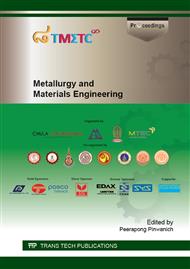p.31
p.36
p.42
p.53
p.59
p.64
p.69
p.76
p.81
Effect of Copper and Zinc on Microstructures, Melting Points and Corrosion Resistance of Sn-Zn-Cu-Bi Soldering Alloys
Abstract:
Sn-Zn alloy is one of the Pb-free systems that are promising because of its relatively low melting temperature and low cost. However, Zn exhibits poor corrosion and oxidation resistance that hinders its soldering applications. The objective of this research is to study the effect of Zn and Cu alloying contents on the Sn-Zn performance. Four compositions of Sn-Zn alloys were studied in this research including: Sn-7Zn, Sn-9Zn, Sn-9Zn-2Cu-Bi, and Sn-9Zn-4Cu-Bi. The microstructures were studied using Optical Microscope (OM) and Scanning Electron Microscope (SEM). The melting temperatures and corrosion resistance of the alloys were evaluated by Differential Scanning Calorimeter (DSC) and Potentiodynamic Polarization technique, respectively. The results showed that an increase in the Cu-to-Zn ratio led to better corrosion resistance. The selective corrosion of the Zn-rich phase could be visibly observed, with OM, on the post-corrosion samples. With the Cu alloying, the Cu and Zn formed an intermetallic compound resulting in a higher value of Ecorr. However, the higher Cu content caused a significant increase in the liquidus temperature due to the Cu-Zn intermetallic compound, of which the melting temperature is higher than 400 °C, resulting in an incomplete melting at low temperature.
Info:
Periodical:
Pages:
59-63
Citation:
Online since:
July 2015
Price:
Сopyright:
© 2015 Trans Tech Publications Ltd. All Rights Reserved
Share:
Citation:


